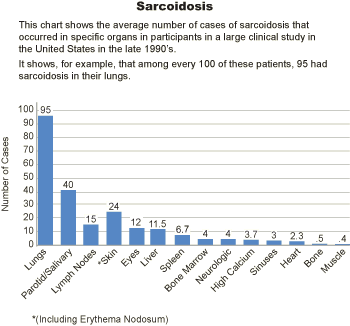What Are the Signs and Symptoms of
Sarcoidosis?
Many people who have sarcoidosis have
no symptoms. Often, the condition is discovered by accident only because a
person has a chest x ray for another reason, such as a pre-employment x ray.
Some people have very few symptoms, but
others have many.
Symptoms usually depend on which organs
the disease affects.
Lung Symptoms
- Shortness of breath
- A dry cough that doesn't bring up phlegm (flem),
or mucus
- Wheezing
- Pain in the middle of your chest that gets worse
when you breathe deeply or cough (rare).
Lymph Node Symptoms
- Enlarged and sometimes tender lymph
nodes—most often those in your neck and chest but sometimes those under
your chin, in your arm pits, or in your groin.
Skin Symptoms
- Various types of bumps, ulcers, or, rarely, flat
areas of discolored skin, that appear mostly near your nose, eyes, back, arms,
legs, and scalp. They usually itch but aren't painful. They usually last a long
time.
- Painful bumps that usually appear on your ankles
and shins and can be warm, tender, red or purple-to-red in color, and slightly
raised. This is called
erythema nodosum (er"i-the'mah nodo'sum). You may have fever
and swollen ankles and joint pain along with the bumps. The bumps often are an
early sign of sarcoidosis, but they occur in other diseases too. The bumps
usually go away in weeks to months, even without treatment.
- Disfiguring skin sores that may affect your nose,
nasal passages, cheeks, ears, eyelids, and fingers. This is called lupus pernio
(loo'pus per'nio). The sores tend to be ongoing and can return after treatment
is over.
Eye Symptoms
- Burning, itching, tearing, pain
- Red eye
- Sensitivity to light
- Dryness
- Floaters (i.e., seeing black spots)
- Blurred vision
- Reduced color vision
- Reduced visual clearness
- Blindness (in rare cases).
Heart Symptoms
- Shortness of breath
- Swelling in your legs
- Wheezing
- Coughing
- Irregular heartbeat, including palpitations (a
fluttering feeling of rapid heartbeats) and skipped beats
- Sudden loss of consciousness
- Sudden death.
Joint and Muscle Symptoms
- Joint stiffness or swelling—usually in your
ankles, feet, and hands.
- Joint pain.
- Muscle aches (myalgias).
- Muscle pain, a mass in a muscle, or muscle
weakness.
- Painful
arthritis in your ankles that results from erythema nodosum.
It may need treatment but usually clears up in several weeks.
- Painless arthritis that can last for months or
even years. It should be treated.
Bone Symptoms
- Painless holes in your bones.
- Painless swelling, most often in your fingers.
- Anemia that results from granulomas affecting your bone
marrow. This usually should be treated.
Liver Symptoms
- Fever
- Fatigue
- Itching
- Pain in the upper right part of your abdomen,
under the right ribs
- Enlarged liver.
Parotid (pah-rot'id) and Other
Salivary Gland Symptoms
- Swelling, which makes your cheeks look puffy
- Excessive dryness in your mouth and throat.
Blood, Urinary Tract, and Kidney
Symptoms
- Increased calcium in your blood or urine, which
can lead to painful kidney stones
- Confusion
- Increased urination.
Nervous System Symptoms
- Headaches.
- Vision problems.
- Weakness or numbness of an arm or leg.
- Coma (rare).
- Drooping of one side of your face that results
from sarcoidosis affecting a facial nerve. This can be confused with
Bell's palsy, a disorder that may be caused by a virus.
- Paralysis of your arms or legs that results from
sarcoidosis affecting your spinal cord.
- Weakness, pain, or a "stinging needles" sensation
in areas where many nerves are affected by sarcoidosis.
Pituitary (pi-tu'i-tar"e) Gland
Symptoms (Rare)
- Headaches
- Vision problems
- Weakness or numbness of an arm or leg
- Coma (rare).
Other Symptoms
- Nasal obstruction or frequent bouts of
sinusitis.
- Enlarged spleen, which leads to a decrease in
platelets in your blood and pain in your upper left abdomen. Platelets are
needed to help your blood clot.
Sarcoidosis may also cause more general
symptoms, including:
- Uneasiness, feeling sick (malaise), an overall
feeling of ill health
- Tiredness, fatigue, weakness
- Loss of appetite or weight
- Fever
- Night sweats
- Sleep problems
These general symptoms are often caused
by other conditions. If you have these general symptoms but don't have symptoms
from affected organs, you probably do not have sarcoidosis.
Sarcoidosis
This graph shows the average number of
cases of sarcoidosis that occurred in specific organs in participants in a
large clinical study in the United States in the late 1990s. It shows, for
example, that among every 100 of these patients, 95 had sarcoidosis in their
lungs.

ACCESS Study, Am J
Respir Crit Care Med, Vol. 164, p. 1885, 2001
|

